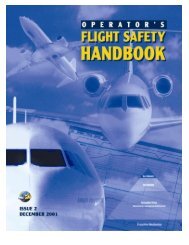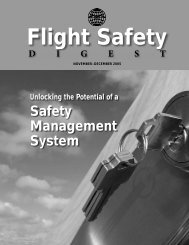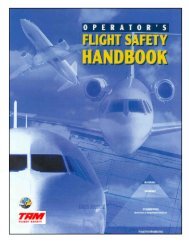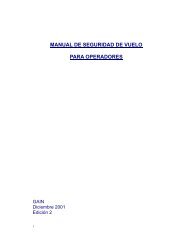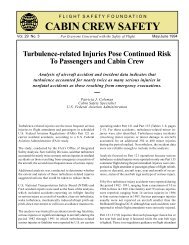Download PDF [10.9 MB] - Flight Safety Foundation
Download PDF [10.9 MB] - Flight Safety Foundation
Download PDF [10.9 MB] - Flight Safety Foundation
You also want an ePaper? Increase the reach of your titles
YUMPU automatically turns print PDFs into web optimized ePapers that Google loves.
© Ryan Hothersall/Jetphotos.net<br />
CAUSALFACTORS<br />
BY LINDA WERFELMAN<br />
Regulatory authorities should alter the certification<br />
requirements for light helicopter<br />
designs to reduce the risk of accidents involving<br />
loss of main rotor control, the U.K.<br />
Air Accidents Investigation Branch (AAIB) says.<br />
The AAIB included its recommendations to<br />
the European Aviation <strong>Safety</strong> Agency (EASA)<br />
and the U.S. Federal Aviation Administration<br />
(FAA) in its final report on the Jan. 6, 2012,<br />
crash of a Robinson R22 Beta near Ely, Cambridgeshire,<br />
England.<br />
The accident killed the 50-year-old pilot<br />
— a flight instructor in airplanes with nearly<br />
A fatal accident involving a Robinson R22<br />
has prompted a call for revised certification<br />
requirements for light helicopters.<br />
5,000 flight hours who was trying to increase<br />
his 58 hours in helicopters so that he could earn<br />
a commercial helicopter license and a license<br />
to instruct in helicopters. The helicopter was<br />
destroyed.<br />
The AAIB report said the cause of the accident<br />
was “main rotor divergence resulting<br />
in mast bumping” — a condition in which the<br />
main rotor hub contacts the main rotor mast. As<br />
the rotor blades continue to “flap,” each contact<br />
becomes more violent, and the result can be<br />
damage to the rotor mast or separation of the<br />
main rotor system from the helicopter.<br />
34 | FLIGHT SAFETY FOUNDATION | AEROSAFETYWORLD | MAY 2013


![Download PDF [10.9 MB] - Flight Safety Foundation](https://img.yumpu.com/18550968/36/500x640/download-pdf-109-mb-flight-safety-foundation.jpg)

![Download this Issue [PDF 7 MB] - Flight Safety Foundation](https://img.yumpu.com/18859635/1/190x245/download-this-issue-pdf-7-mb-flight-safety-foundation.jpg?quality=85)
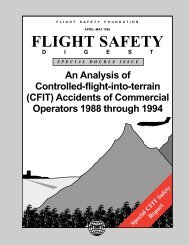
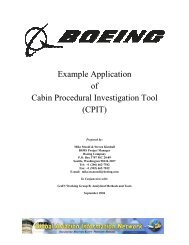
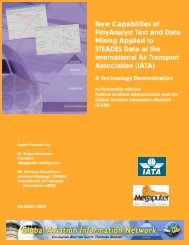
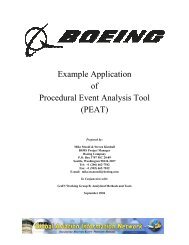

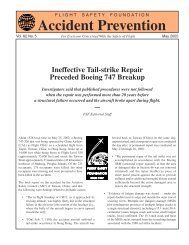
![Download [PDF 8 MB] - Flight Safety Foundation](https://img.yumpu.com/18859366/1/190x245/download-pdf-8-mb-flight-safety-foundation.jpg?quality=85)
